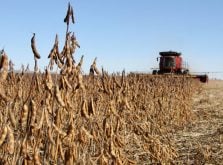American scientists have identified another cause of global climate change, and it originates in farm fields around the world.
The Clean Air Task Force (CATF), a nonprofit research group based in Boston, Massachusetts, says smoke and soot from agricultural fires is contributing to global warming and the loss of ice in the Arctic.
The task force, aimed at reducing atmospheric pollution, released a report last month suggesting agricultural fires in Russia, Kazakhstan, China, Ukraine, the United States and Canada disrupt the Arctic climate in two ways:
Read Also

Manitoba extends Crown land rent freeze
Manitoba government links the continued rental rate freeze on grazing and forage leases to economic and environmental challenges facing the industry
- They cause an airborne haze that absorbs solar radiation and warms the troposphere, creating a greenhouse effect in Arctic regions.
- As the particulate matter in smoke settles to the earth, it creates a thin layer of soot on Arctic snow and ice that reduces solar reflectivity, increases solar absorption and speeds melting.
The task force’s report says scientists have long known that forest fires contribute to atmospheric pollution in the Arctic, but they have traditionally paid less attention to agricultural burning.
“There is increasing evidence that agriculture-related fires have been underrated as a source of Arctic black carbon,” the report said.
“The task of reducing black carbon’s impact on the Arctic demands a concerted, region-specific approach to agricultural fires – one that combines economically viable innovation with increased monitoring and regulation.”
Ellen Baum, a senior scientist with the Clean Air Task Force, said it is difficult to gauge the exact impact of agricultural fires on Arctic climates.
Agricultural burning is probably not a major contributor to global warming, she added, but it is a practice that could easily be reduced with better monitoring, regulation, enforcement and education.
“There’s a growing concern about the Arctic and really, we’re looking under any rock for things that we easily can do (to mitigate climate change),” she said.
“Unlike CO2, where we really have a hard time knowing what to do about it … there really are policies and mechanisms that would really work in reducing agricultural burning. But I think it will be very challenging to implement them because you need a commitment to regulation and enforcement.”
Baum said timing of agricultural burning is also a key factor.
Spring burns are more harmful than autumn burns because the soot from autumn burns falls on ice that has already melted during the Arctic summer.
By comparison, soot from spring burns lands on ice and snow that is receiving its first rays of sunlight after a long polar winter. Spring melting begins earlier because the soot reduces reflectivity and increases absorption of sunlight.
“It’s not that fall burning would have no impact at all,” Baum said.
“It’s just that its impact would be much greater in the spring.”
According to CATF, recent advances in satellite technology have enabled researchers to pinpoint the location and frequency of agricultural fires throughout the northern hemisphere.
Using an instrument known as the Moderate Resolution Imaging Spectroradiometer (MODIS), scientists determined that agricultural burning occurs most frequently in Russia, Kazakhstan and other Eastern European locations.
Between 2004 and 2007, for example, Russian farmers produced more than 80 percent of the black carbon that originated from agricultural burning. They were followed by producers in Kazakhstan at 5.5 percent, China at 2.9 percent, and the United States and Canada at 1.3 percent.
In Canada, most agricultural burning occurs in southern Alberta, Saskatchewan and western Manitoba.
In Saskatchewan, which contains 40 percent of Canada’s farmland, permits are not required for agricultural burning.
Instead, provincial officials rely on farmers to incorporate their straw and to avoid burning unless it is absolutely necessary.
In 2008, Saskatchewan Agriculture conducted a survey of 400 producers and determined that flax straw is the province’s most commonly burned crop residue.
According to the survey, 65 percent of flax growers burn flax straw compared to 13 percent of canola growers, 11 percent of pulse growers and eight percent of cereal growers.
When asked if agricultural burning should be regulated, 62 percent of respondents said no. Nine percent supported an outright ban on all types of agricultural burning.
Julienne Stroeve, a researcher with the National Snow and Ice Data Centre in Boulder, Colo., said sea ice in the Arctic is diminishing at a rate of approximately 12 percent per decade.
“Certainly, the loss of sea ice is the biggest climate signal that we have right now,” she said. “If you look at the late 1970s, it’s about a 40 percent reduction right now.”















